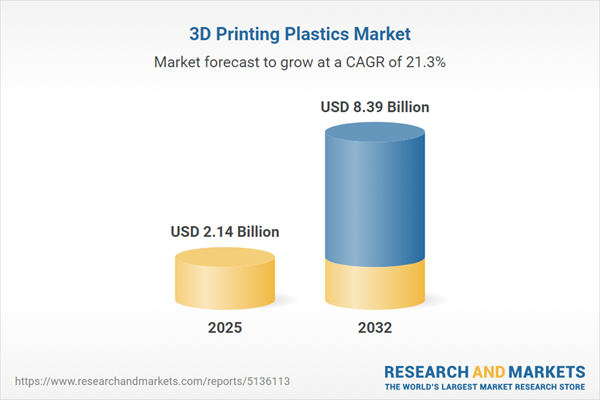Speak directly to the analyst to clarify any post sales queries you may have.
The 3D printing plastics market empowers manufacturing leaders to achieve greater flexibility, streamline processes, and drive innovation in response to evolving industrial requirements. As industrial organizations look to optimize efficiency and quality, understanding material and technology trends remains essential for effective strategic planning.
Market Snapshot: 3D Printing Plastics Market Size and Growth
In 2024, the 3D printing plastics market reached USD 1.78 billion, demonstrating significant momentum fueled by expanding adoption across diverse industries. The marketplace continues its evolution beyond traditional prototyping, supported by advancements in polymer resilience and the seamless integration of plastics into more rigorous industrial settings. Aerospace, automotive, and healthcare sectors are leading this transition, leveraging the benefits of additive manufacturing to address changing compliance demands and improve speed to market. As polymer technologies develop, organizations increasingly utilize sophisticated additive manufacturing to elevate operational efficiency and redefine quality benchmarks.
Scope & Segmentation of the 3D Printing Plastics Market
Understanding detailed segmentation within the 3D printing plastics market enables executives to tailor procurement and risk mitigation strategies. Each segment presents tangible benefits, aligning with business needs and long-term objectives, and clarifies the path to value creation and innovation across manufacturing environments.
- Plastic Types: ABS, Nylon, Polycarbonate, PETG, PLA, and TPU each offer unique balances of strength, flexibility, and durability, serving applications from rapid prototyping to full-scale production where material reliability and customization are critical.
- Form: Filament, pellets, granules, resin, powders, and sheets support tailored workflows. Selecting the right form allows companies to scale additive manufacturing while maintaining process control and adapting to changing production demands.
- Printing Technologies: FDM/FFF, Material Jetting, Multi Jet Fusion, SLS, and SLA/DLP each deliver varying levels of accuracy, surface finish, and throughput capabilities, making technology selection pivotal for organizations engineering complex products.
- Applications: Both prototyping and end-use parts benefit, helping firms efficiently validate new products, lower risk, and accelerate the innovation-to-market cycle in competitive sectors.
- End-User Industries: Aerospace, defense, automotive, healthcare, construction, manufacturing, consumer goods, education, research, and architecture each require careful materials selection to satisfy distinct safety, compliance, and performance standards.
- Distribution Channels: Direct, digital, and traditional supply models foster flexible sourcing and enable rapid scale-up to meet fast-changing project needs or market shifts, supporting strong supply chain agility.
- Regions: Americas, Europe, Middle East & Africa, and Asia-Pacific reflect nuanced differences in regulatory environments, supply chain complexity, and adoption pace, making localization key to market access and success.
- Companies: Market-leading organizations such as BASF SE, Covestro AG, Evonik Industries AG, Arkema S.A., Koninklijke DSM N.V., Saudi Basic Industries Corporation, Stratasys Ltd., 3D Systems Corporation, DuPont de Nemours, Inc., Eastman Chemical Company, and Proto Labs, Inc. shape the competitive landscape by investing in targeted R&D and continuous process innovation.
Key Takeaways for Senior Decision-Makers
- Specialized 3D printing plastics enhance compliance and ensure reliable output for industries responding to shifting safety and quality standards.
- Growing use of bio-based and recycled polymers supports sustainability goals and strengthens alignment with corporate environmental strategies.
- Custom polymer solutions offer companies the flexibility to adapt product designs and extend the lifecycle of mission-critical parts, improving overall return on investment.
- Digitized regulatory and manufacturing workflows support enhanced oversight and reduce production risks while maintaining transparency across operations.
- Regional supply chain development and strategic partnerships help enterprises manage local compliance challenges and deliver optimal solutions in diverse regulatory settings.
Tariff Impact: 2025 U.S. Tariff Policies and Supply Chain Adjustments
Recent U.S. tariffs on resins and polymers are leading organizations to adjust procurement strategies by prioritizing regional and domestic suppliers. This transition reinforces supply chain resilience and operational continuity while supporting commitments to sustainable and circular manufacturing models in a complex regulatory landscape.
Methodology & Data Sources
This report synthesizes insights from in-depth executive interviews, expert technical reviews, and established industry databases. A rigorous validation process ensures findings remain actionable, current, and reflective of accelerating developments within the additive manufacturing ecosystem.
Why This Report Matters for the 3D Printing Plastics Market
- Guides senior leaders in optimizing sourcing and procurement strategies as additive manufacturing scales beyond prototyping into core production workflows.
- Enables informed material and technology decisions, supporting improved operational efficiency, stronger risk management, and progress toward sustainability goals.
- Delivers reliable, data-driven insights necessary for effective strategic planning in innovation-intensive, compliance-driven industries.
Conclusion
This report provides actionable market intelligence and detailed segmentation, positioning decision-makers to navigate opportunities and uncertainties in the evolving world of 3D printing plastics.
Additional Product Information:
- Purchase of this report includes 1 year online access with quarterly updates.
- This report can be updated on request. Please contact our Customer Experience team using the Ask a Question widget on our website.
Table of Contents
3. Executive Summary
4. Market Overview
7. Cumulative Impact of Artificial Intelligence 2025
Companies Mentioned
The companies profiled in this 3D Printing Plastics market report include:- BASF SE
- Covestro AG
- Evonik Industries AG
- Arkema S.A.
- Koninklijke DSM N.V.
- Saudi Basic Industries Corporation
- Stratasys Ltd.
- 3D Systems Corporation
- DuPont de Nemours, Inc.
- Eastman Chemical Company
- Proto Labs, Inc.
- Apium Additive Technologies GmbH
- Dream Polymers
- EOS GmbH
- Henkel AG & Co. KGaA
- HP Inc.
- INTAMSYS Technology Co. Ltd.
- LEHVOSS Group
- Materialise NV
- Nantong NTEC Monofilament Technology Co.,Ltd
- Shenzhen Kings 3D Printing Technology Co.,Ltd.
- Solidspace Technology LLP
- Solvay S.A.
- Torwell Technologies Co., Ltd.
- Xometry, Inc.
Table Information
| Report Attribute | Details |
|---|---|
| No. of Pages | 186 |
| Published | November 2025 |
| Forecast Period | 2025 - 2032 |
| Estimated Market Value ( USD | $ 2.14 Billion |
| Forecasted Market Value ( USD | $ 8.39 Billion |
| Compound Annual Growth Rate | 21.3% |
| Regions Covered | Global |
| No. of Companies Mentioned | 26 |









